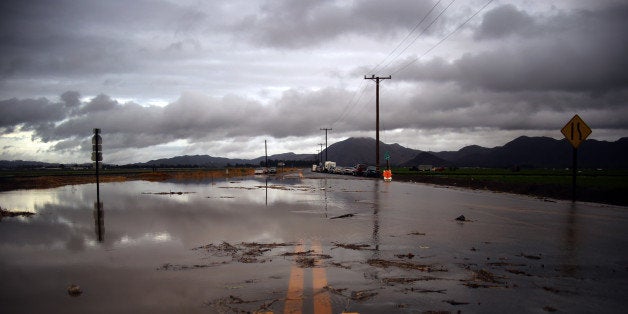
It seems a bit strange, I will admit, to sit here writing about water shortages and droughts and rationing while my roof is leaking in two places, into a carefully positioned large blue bucket and a smaller yellow one. And the news is full of forecasts of the coming torrents of rain that El Niño will bring us -- not that we've seen very much of it yet here in San Diego.
But it is not likely that massive and sudden rains will save us and end California's drought. Here is what we need: slow, steady drizzle, with most of it falling in the mountains (snow is fine) or on the center of the state. Why -- because most of the above ground storage in the state is associated with drainages in the center and north, especially the larger reservoirs like Shasta, Folsom Lake and others. In addition to the runoff captured in rivers feeding into lakes/reservoirs it is important to replenish the ground water, since many areas are largely or completely dependent on wells for their water supply. But it takes time for the rain to soak into the ground. The USGS estimates that depending on the nature of the geology, underground water travels as little as a foot per month, or in very favorable settings, a foot per day. So the recharge the aquifer from which a 200 foot well draws obviously takes two hundred days, or much more.
Too much rain in too short a time along the coast simply flows into drainage channels and then into sewage treatment facilities or directly into the ocean. This is of no storage benefit, obviously. The Los Angeles River is lined with concrete, for example, and although it drains a large area (much of which is covered with paving or housing -- it's called a "city"), once the water is in the channel, it's certainly not going to percolate into ground water aquifers. The same is true of major drainage canals in San Diego and elsewhere. This is efficient for clearing potential floods, but of no value in rebuilding our inventory of water we can use when the rain stops.
The drought in California has been steadily building for four years, and so, simply speaking it could take four years of excess rain, in the rainy season, to eliminate it. The numbers aren't quite that bad, but a couple of showers, or a season of 120% of normal rainfall won't cut it.
So... if the drought is going to hang around for a while longer, what should your water utility be doing?
1.Get the State Water Board to set more sensible rules. I have already written about how poorly drafted these rules are, and I am not alone in making these complaints. The Board has proposed some small changes, and the time to comment on them is now. If your utility hasn't commented, then it should. The rules currently in force are too much a "one size fits all" set of proscriptions put together in a hurry, largely ignoring comments from the regulated community. For example, although San Diego has underwritten the construction of a billion dollar desalination plant that is now on line and providing 7 to 10 percent of the region's water, the rules give San Diego no credit for this laudable effort. There also need to be adjustments for water utilities whose customers include farms, even if these are not large. The rules were designed for urban customers and the targets need to be set for urban customers. The Board's potential changes were released on 15 January, with comments due back to the State Board no later than noon on Thursday January 28. A fact sheet describing the changes and the comment process can be found here.
The small changes being proposed do allow a "credit," capped at 8 percent of usage, for desal water. But why the cap? If you were willing to buy 100 percent of your water from a desal facility, and pay the increased price, why should you be subject to any drought rules? Instead, you should get full credit for this initiative in drought proofing your supply. Similarly, agencies can deduct agricultural water use from their base against which savings are counted, but must submit an "Agriculture Plan" to deal with this use. More plans that no one will really look at and that just cost time and money are a silly idea.
2.In San Diego, the new desalination plant sells all of its water to the San Diego County Water Authority, who is contractually obligated to purchase this water, regardless of its other supply options. The Authority then resells it to the 24 local agencies that are its customers, according to its standard rules. This "take or pay" contract allowed Poseidon, the project's developer and owner, to finance the plant with substantial debt, and thus to lower the ultimate cost of the water. But two local agencies, Carlsbad and Vallecitos, elected to sign "back to back" contracts directly with the water district, for specific amounts of desal water. Your water utility should do so as well, immediately. What this will do is assure that you will get whatever you contract for from the plant, not just your seven or ten or thirteen percent prorata share of what goes to San Diego. This could be quite important if the drought continues and the San Diego Authority's other sources dry up and they begin to ration all their water, including the desal water. The amount for which you have contracted won't be subject to this rationing or other limitations as you have your own direct supply.
3.Support another desal plant. While we're on the subject of desal, the water utility should take a public position encouraging the Poseidon company to immediately start work on permitting a second desal plant at Encinas, the Carlsbad faculty. There is land, there is excess capacity in the water intake and outfall structures, and the permitting will take some time due to the difficulty of dealing with the Coastal Commission. The first plant took ten years to get permitted and 18 months to build. Best to get started now.
Potable reuse is another equivalent opportunity which uses the same reverse osmosis technology as salt water desalination. It is being seriously studied by San Diegito in concert with the San Elijo Joint Powers Authority. This is an important initiative and should continue. Although the first time this was suggested, it foundered on the public distaste for the "toilet to tap" label that was (correctly) hung on it by project opponents. Perhaps we are either wiser or more desperate now.
4.Begin a cost of service study of your water supply. Nothing works better than markets, and for a period local water distributors were using "tiered rates" which charged more per unit as customer usage went up. But a court case in April of 2015, subsequently upheld by the California Supreme court, ruled that such rates were illegal, based on California proposition 218, as they did not reflect the costs to the distributor. So you need a study to prove that in fact new supplies of water are more costly than old supplies -- the desal water from Carlsbad is about twice as expensive as existing supply, for example -- and thus such rates are in compliance with the law. These studies are easy to do, and are traditional in the electric utility industry, but they must be done professionally in order to withstand future challenges. Once the study is complete, assuming its conclusions are as hypothesized above, then rates can be adjusted to include economic disincentives for high consumption customers. This will work far better than appeals to good behavior.
5.There are no real water markets in California. Any material transfer of water rights between agencies and or users holding these rights needs to be individually approved by the State Water Board. Yes, that is exactly as nutty as it sounds. There have been some water transfers from the Imperial Valley Irrigation District to San Diego, but they were painful to accomplish. This law obviously needs to be changed so that the state's limited water supply can be allocated to its most valuable use. This is another effort that will require local political support and lobbying, but the time to get going on this is now.
6.Purple pipe water for all. Some treated water which does not meet potable standards but does meet EPA standards for disposal, is now allowed to be used for landscape irrigation. This works because the disposal standards are quite stringent, since no one wants the ocean, the ultimate destination of water treated at waste water facilities, to turn into one big toilet. This "agricultural quality" water is currently distributed on a limited basis through a second set of pipes, cleverly colored purple so no one gets confused about which water is which. But laying a duplicate set of pipes to all homes and businesses and farms is quite expensive and disruptive, and when it rains a lot, who cares? But more can easily be done. What has been done in several northern California jurisdictions like San Francisco and Healdsburg, as well as Olivenhain in San Diego, is to sell this water at the water treatment site, and let people with tanks, who really care about their lawns and gardens, buy it from the plant. What will actually happen is not that everyone in Rancho Santa Fe will buy a pickup truck and put a tank in the back, but rather that clever entrepreneurs will lease large tank trucks and offer a watering service on a weekly basis to a set of customers. The San Elijo waste water treating plant, for example, is making four times as much "purple pipe water" as it can sell through the separate pipe system, and could with modest cost and effort set up a "filling station" to sell the excess to tanker trucks. Everyone wins, the water is used at least twice before going into the ocean, and this could be done very quickly.
The data indicate that conservation efforts are starting to fall off. California has missed its 25 percent target for the last two months running. Clearly not all districts have made efforts to conserve. In fact, the State Board has gone so far as to fine four other water entities, including Beverly Hills, Indio, Coachella and Redlands, for missing their targets and not trying hard enough.
No matter how well intentioned we are, we cannot conserve our way out of a prolonged and possibly recurring drought, unless we revert to turning Los Angeles and San Diego into a real desert landscape -- no soccer fields, no palm trees, no eucalyptus lining the major roads, none of the horticultural things that make this such a wonderful place to live. I am personally not that fond of sand and cactus, so I believe we need to take all the actions recommended above. Some are clearly short term and of local and limited impact.
To balance this we should in particular push forward with the best long-term option for increasing drought proof supply: building more desal / reverse osmosis plants, either using sea water or waste water as the input.
